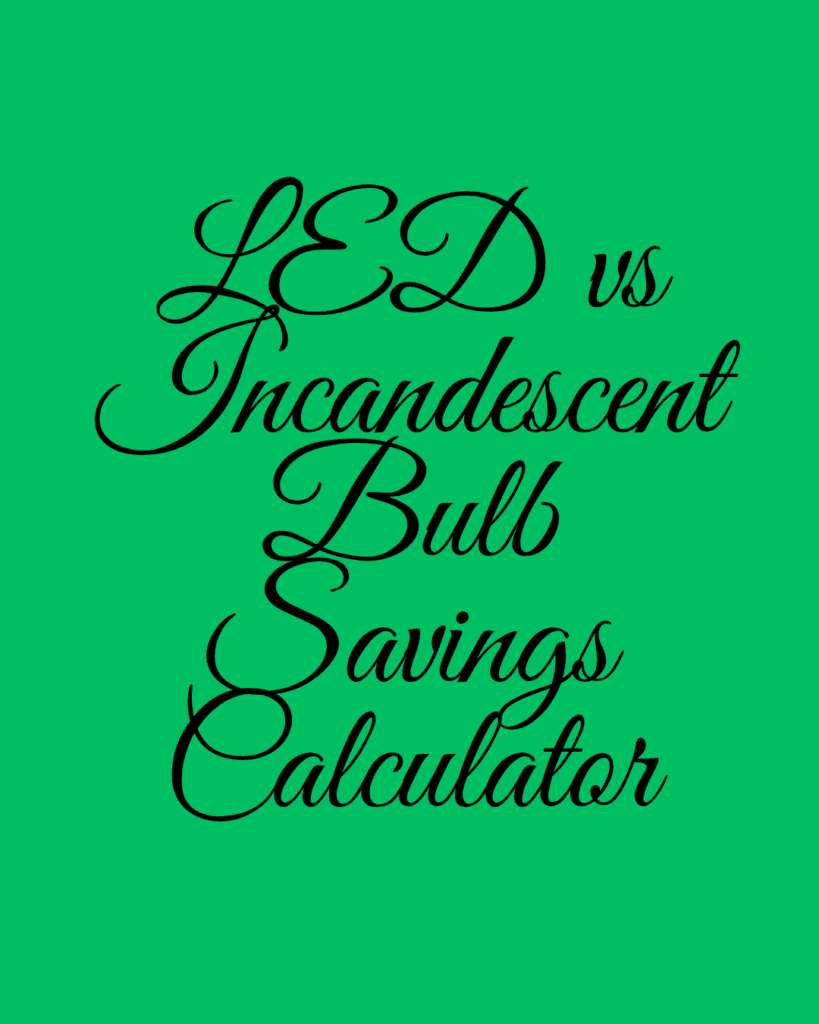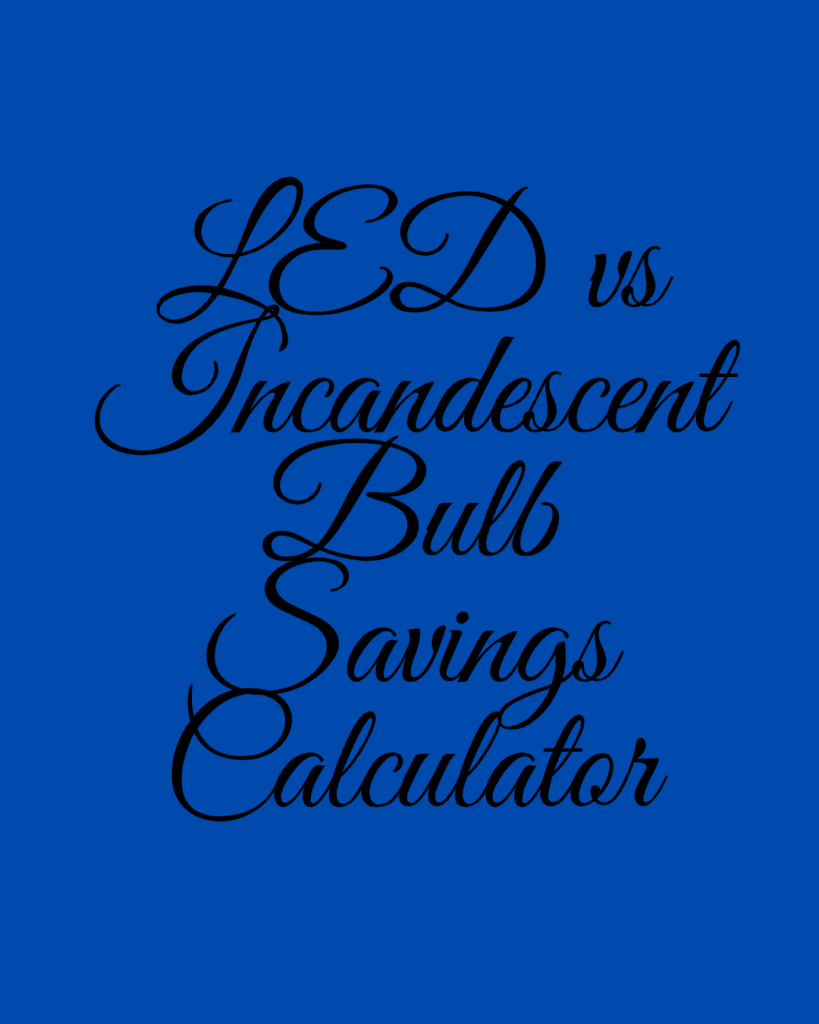LED vs Incandescent Bulb Savings Calculator
Free LED Vs Incandescent Bulb Savings Calculator
Lighting costs can be an ongoing burden for both homes and businesses alike, yet more energy efficient LED bulbs use significantly less electricity than their incandescent or CFL counterparts, lasting much longer and reducing replacement costs significantly.

As LEDs tend to require higher upfront investments, it's essential that you carefully evaluate if their savings in electricity costs and replacement expenses justify switching. To assist you with this decision-making process, we have designed this free LED vs Incandescent Bulb Savings Calculator.
Calculate Your Energy Savings Today
Lighting accounts for about 15% of an average household electricity bill. By switching traditional incandescent and compact fluorescent light bulbs (CFLs) out with energy-efficient alternatives like LED or halogen lights, such as energy efficient bulbs like LED and halogen ones, you can significantly lower your electric bill. Energy efficient bulbs consume significantly less power to operate compared to their counterparts which use incandescence lightbulbs and compact fluorescent lightbulbs (CFLs).
This free LED vs Incandescent Bulb Savings Calculator will help you assess the costs savings of using energy-efficient lighting. It's straightforward and only requires minimal input; simply select which light bulb type to replace. Next, enter its wattage. For those using ENERGY STAR lightbulbs, be sure to enter their wattage as well. Watts measure energy use while lumens indicate brightness.
This calculator will quickly and accurately estimate your lighting costs using national average residential rates (currently $0.13 per kilowatt-hour). Additionally, enter local electricity rates for more accurate results.
To calculate energy savings, simply subtract the wattage of the new light bulb from that of its predecessor and multiply that number by your monthly electricity cost to determine cost savings - you'll quickly see just how much money can be saved each year!
LED bulbs may cost more than their CFL and incandescent counterparts, but they are far more energy-efficient and generally last twice as long, meaning fewer replacements need be purchased or installed frequently - saving both costs and time when used by businesses.
When considering an upgrade in lighting, it is essential to calculate both energy and maintenance costs in order to assess if an investment in LED is beneficial for your business. When doing so, energy savings alone won't tell the entire tale; upfront costs like purchasing fixtures must also be factored in as well as labor expenses from purchasing, installing and replacing bulbs.
Payback Period
Your clients who switch to LED bulbs will save money on energy costs, using less electricity per hour than the old incandescent light bulbs they are replacing, yet the upfront expense remains substantial. Our calculator takes into account both energy savings and replacement cost savings to estimate its payback period and help your clients make this important financial commitment to energy-efficient lighting.
This calculator takes into account both the current incandescent wattage of your client's bulbs, as well as their equivalent LED bulbs, before factoring in cost and any local electricity rates (for state-specific rates see our Electricity Pricing Calculator).
Next, the calculator calculates annual usage hours by multiplying daily hours used by each bulb by 365. It also takes into account labor cost savings associated with not needing to replace as many bulbs - which may be significant for businesses with many fixtures or that depend on technicians for changingover.
As LEDs last much longer than conventional light bulbs, it's clear that over time LEDs will pay for themselves in terms of replacement cost savings alone. This is especially true if your clients save money when purchasing, installing, and disposing of traditional bulbs.
Calculating the return on investment for an LED conversion requires factoring in any utility rebates that your clients qualify for - these rebates may reduce payback periods significantly and make switching even more worthwhile for your clients.
Finally, this calculator considers both upfront costs associated with LED bulbs and any necessary fixture upgrades required for them to fit within existing fixture upgrades (such as retrofitting or complete fixture replacement). These expenses tend to be lower than replacing an existing system with HID or sodium-vapor lights but they can add up when considering an entire facility upgrade project. Consequently, this report can serve as an effective way of showing the value of an LED conversion conversion to clients.
Longevity
LEDs not only save on energy costs, but their longer lifespan also equates to reduced replacements - saving both purchase and installation fees, as well as maintenance time and labor expenses in commercial environments.

This calculator assumes an incandescent bulb lifespan of 1,000 hours and an estimated CFL (compact fluorescent lamp) light lifespan of 8,000 hours; you may adjust these values based on their advertised lifespan of original or replacement bulbs.
Incandescent lighting technology employs a wire filament inside of a glass tube to produce light; however, most of that electricity is lost as heat. Incandescent bulbs are one of the least efficient types of light bulbs on the market; only 5% of their energy converts to visible light output. LED bulbs utilize semiconductor devices which emit visible light when an electronic signal is applied whereas incandescents do not.
LEDs (Light-Emitting Diodes) use only a fraction of the energy consumed by incandescent or CFL bulbs and last up to 20 times longer, making them the more cost-effective long-term choice for home and business lighting fixtures.
To estimate the power consumption of a light fixture, enter its total wattage and electricity rate per kilowatt hour into this calculator. The output provides an annual energy usage estimate, which when multiplied with how many bulbs have been replaced provides total savings in kWh units.
Click "calculate" to get the result, using our watts-to-lumens or kilowatts-to-joules converter as needed for further help. Your results will show how many watts an average light bulb consumes each day, and when it reaches full brightness.
This calculator can also be used to estimate the costs associated with running LED holiday lights, which typically use 0.04 watts per two-inch bulb and make for great outdoor displays that require large amounts of light. Indoor displays might benefit from LED bulbs with warm white colors that mimic traditional incandescent bulbs for added ambiance.
Government Rebates
Numerous commercial and residential energy providers across the country are offering incentives to switch to LED lighting. Not only are LEDs cheaper, they're more environmentally-friendly too! So if you haven't made the switch already, take advantage of rebates available either through your retail power provider or online today - you could receive them either way!
Lighting accounts for as much as 30% of a building's electricity use, making it an excellent place to begin cutting energy costs. LEDs offer many benefits - long lifespan, efficiency, versatility and reduced total energy cost being just some.
LED and incandescent bulbs differ drastically: while the latter use electricity through wire filaments, LED bulbs use an epoxy lens that's much safer for the environment and your fingers; plus they don't produce as much heat and are therefore better suited to high traffic areas or places frequented by children or pets. Plus they last longer without needing replacement as often - saving even more in maintenance costs!
Many states, local municipalities, and energy companies offer rebates for upgrading to LEDs. This can help offset initial installation costs. Rebate programs vary from state to state--even within one state! It is therefore highly advised to work with a lighting as a service company who can guide your upgrade successfully.
Lighting can have an enormous effect on productivity, brand image and energy bills - and TCP's energy-efficient LED options can help you do all three. We offer flat panels, pendants, color selectable tubes and recessed fixtures designed to improve interior spaces.

Are you ready to calculate your savings? Use our LED Energy Savings Calculator to input your utility rates and electricity usage information, then click RESULTS tab to see just how much money can be saved! For an even more in-depth analysis, add extra features (such as smart technology) into the calculation for even greater insight.
